Bệnh xơ phổi: Từ sinh lý bệnh đến thăm dò chức năng hô hấp
Bệnh xơ phổi được đặc trưng bởi sự tích tụ quá mức chất gian bào và tiêu hủy các cấu trúc phổi, dẫn
đến suy hô hấp. Sinh bệnh học của xơ phổi khá phức tạp, phụ thuộc nhiều vào nguyên nhân của bệnh, liên
quan đến nhiều đường dẫn sinh học tế bào và phân tử. Trong bệnh xơ phổi do xơ cứng bì, bằng chứng mô học cho thấy sự hiện diện đồng thời của các tổn thương vi mạch máu, hiện tượng viêm và kích hoạt tự miễn, xen bởi các ổ xơ hóa.
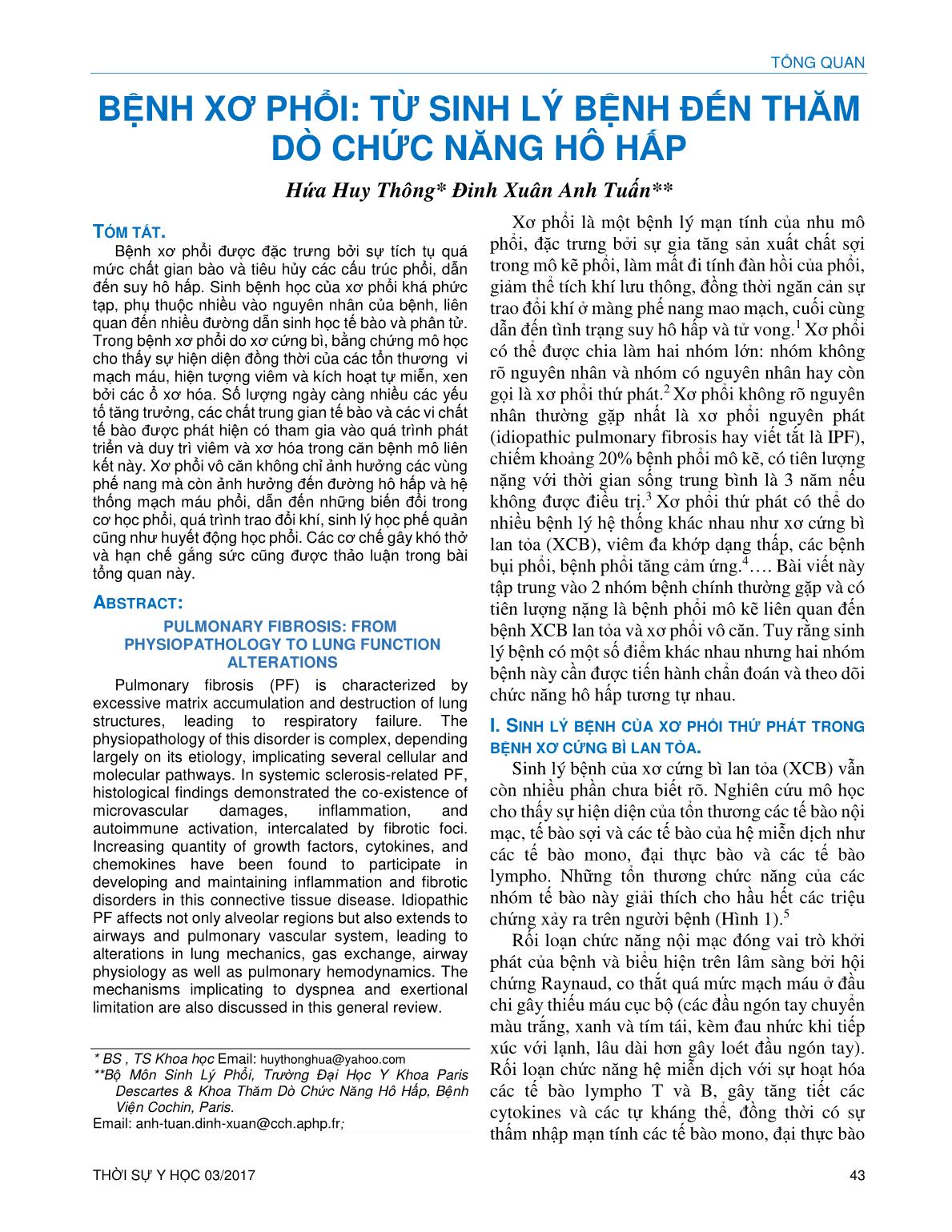
Trang 1

Trang 2
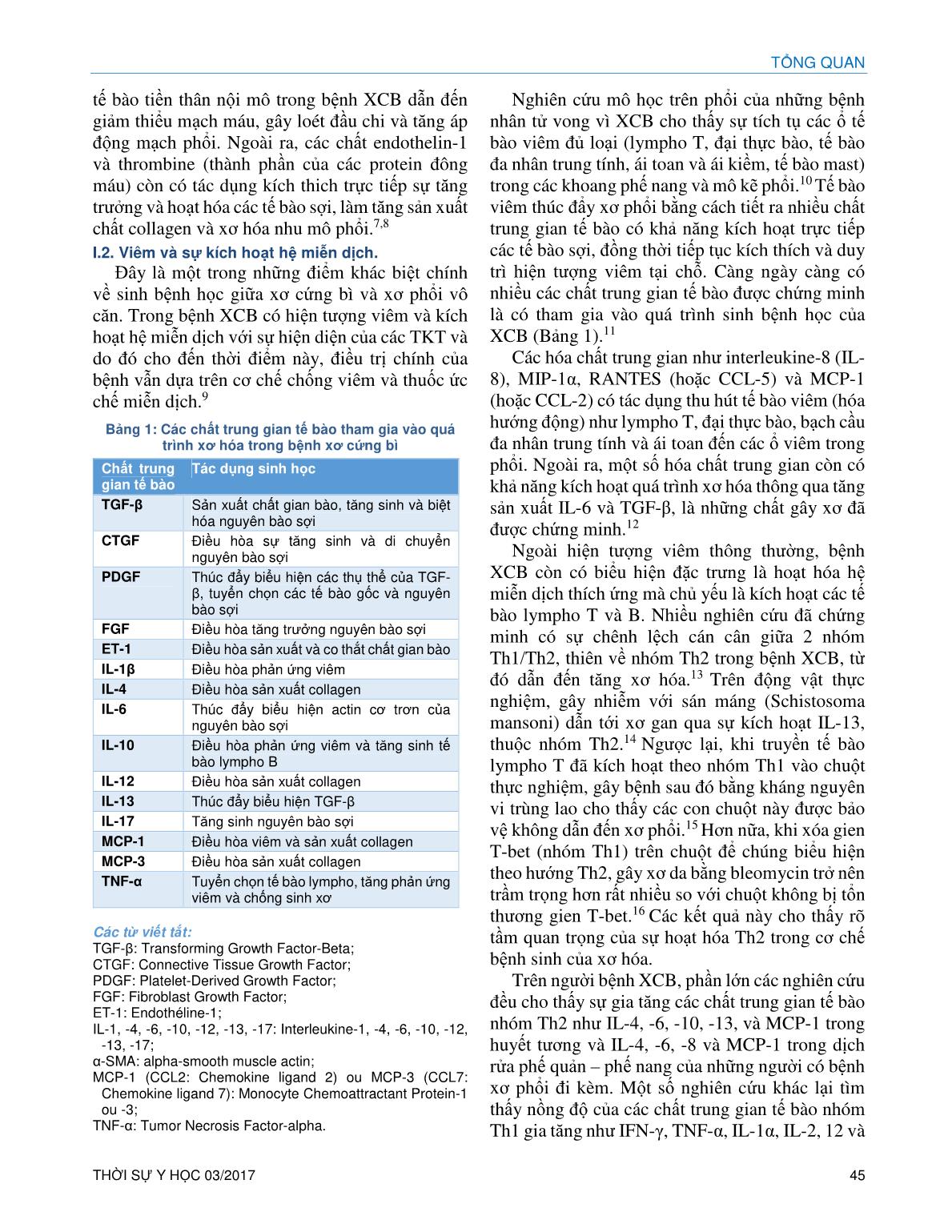
Trang 3
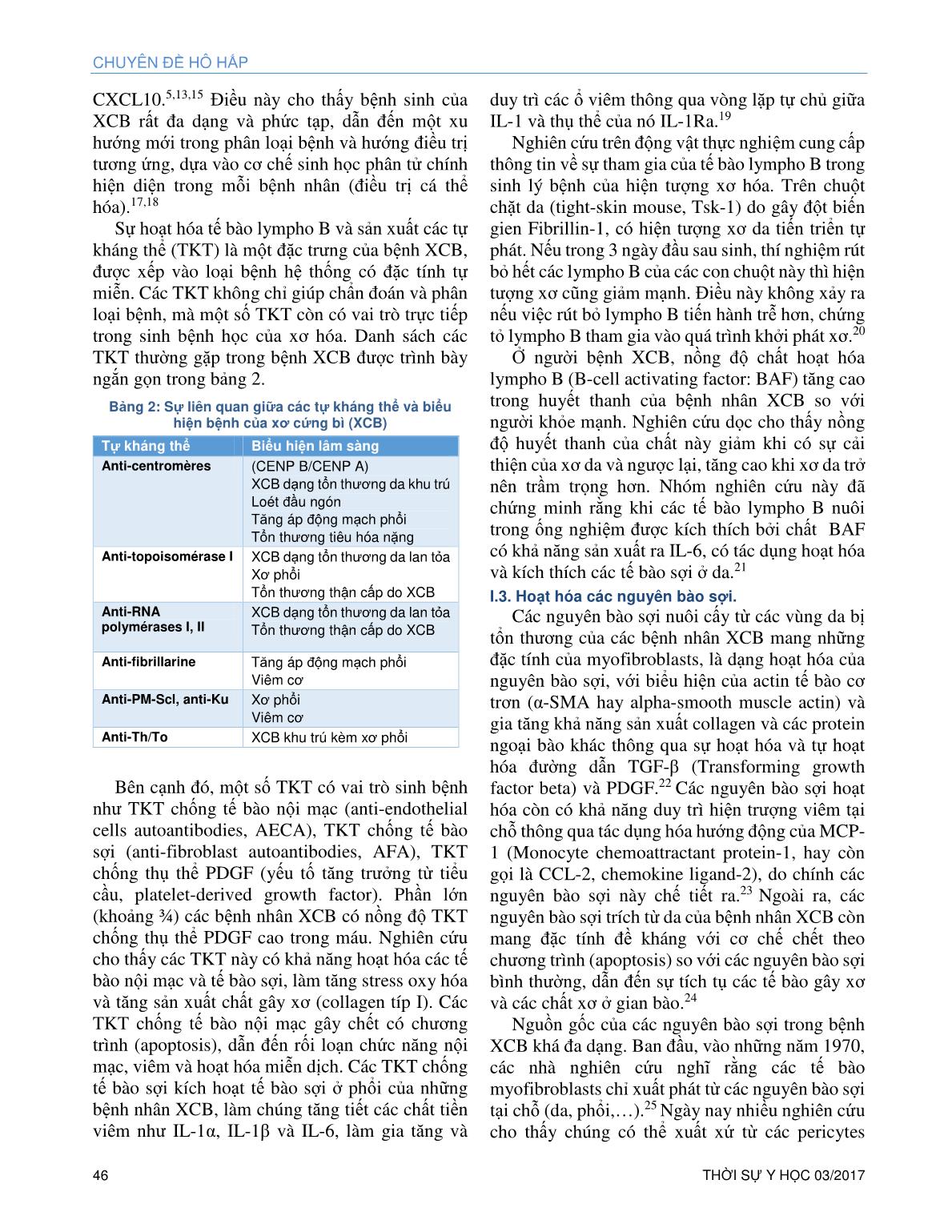
Trang 4
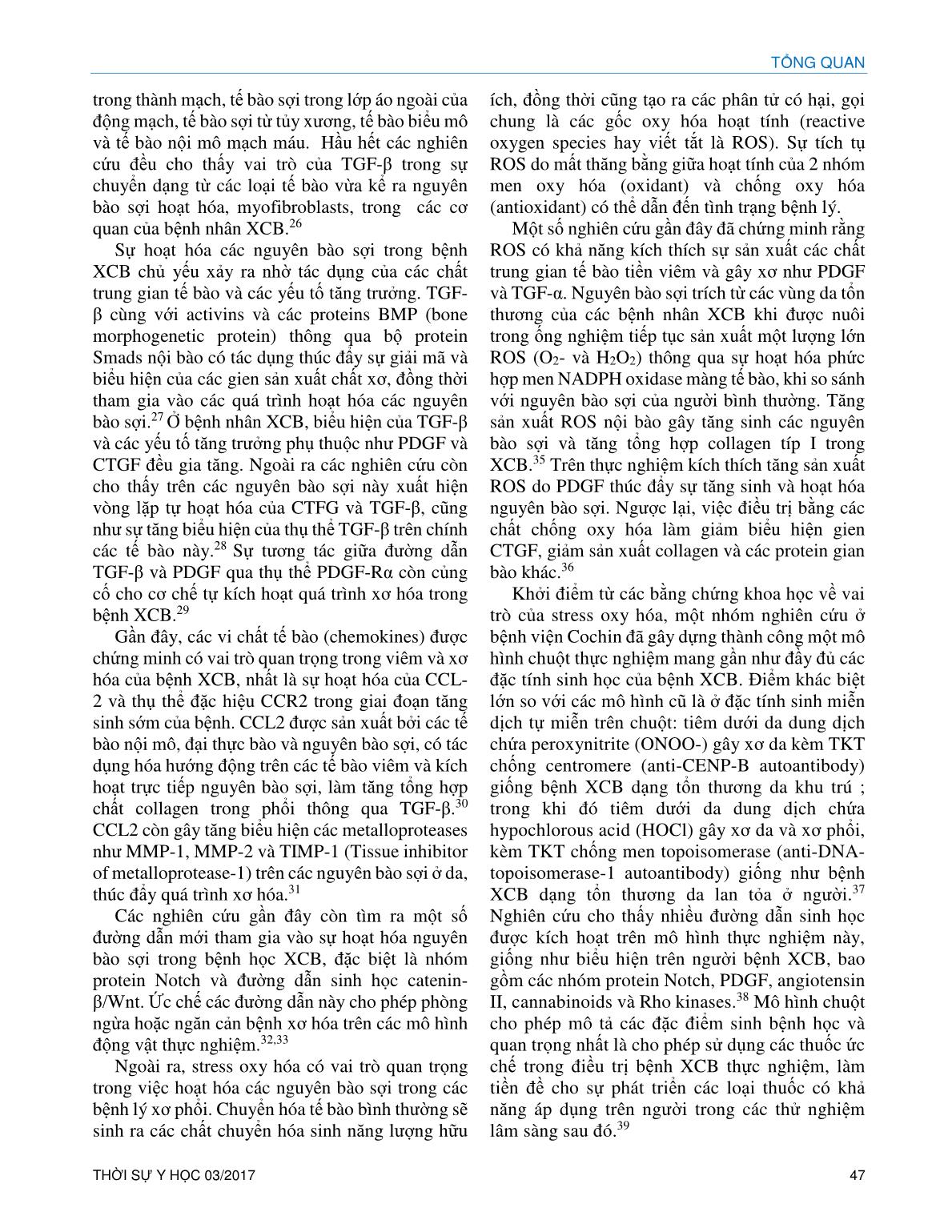
Trang 5
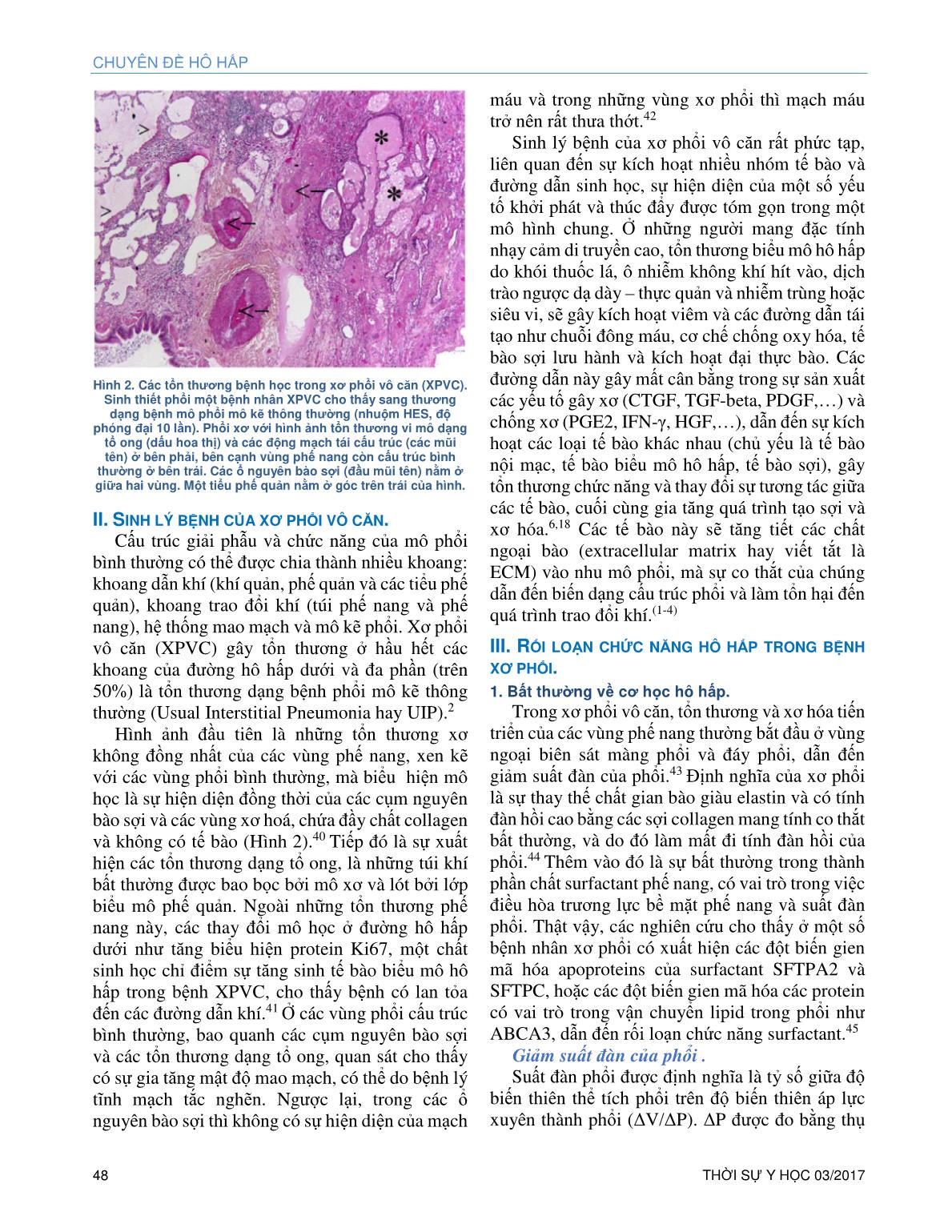
Trang 6
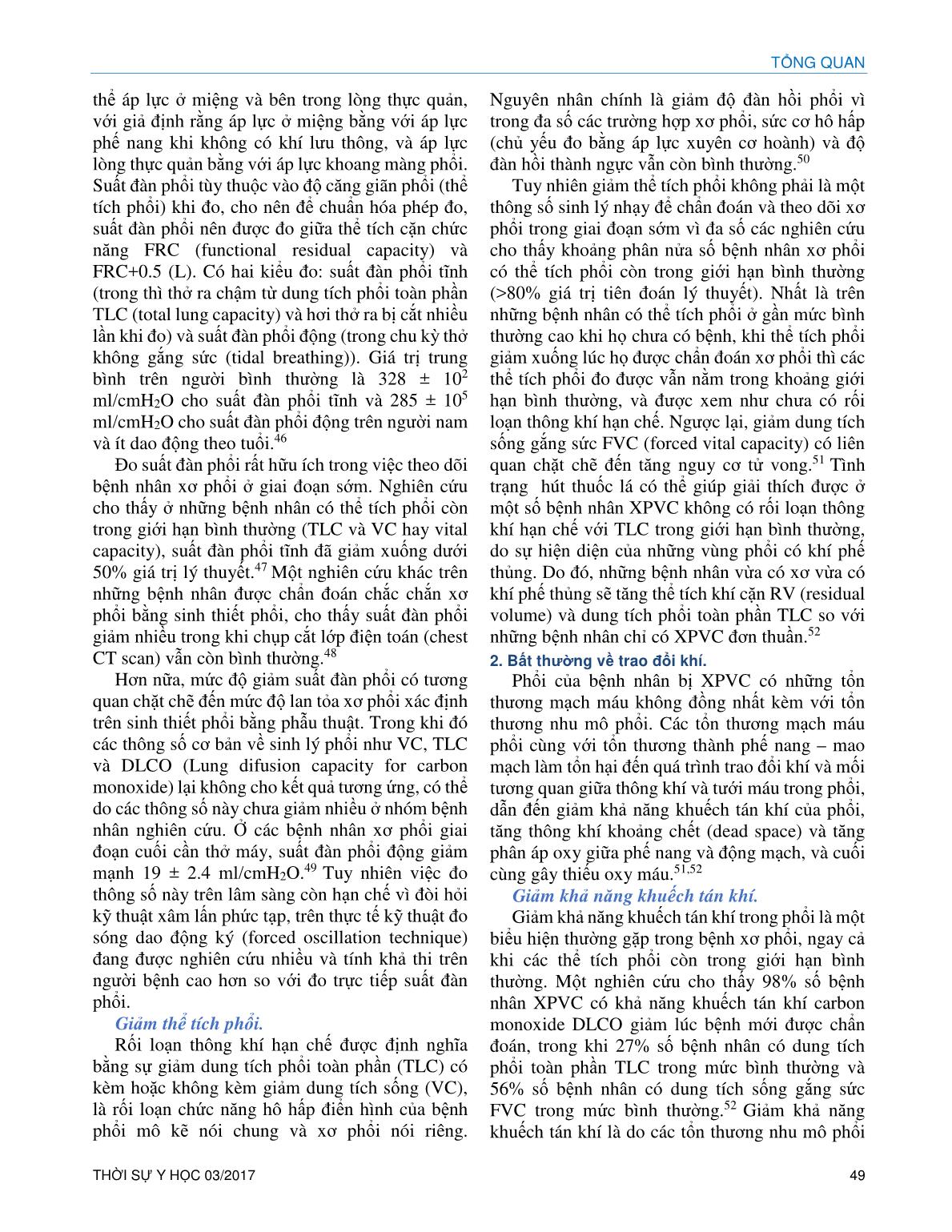
Trang 7
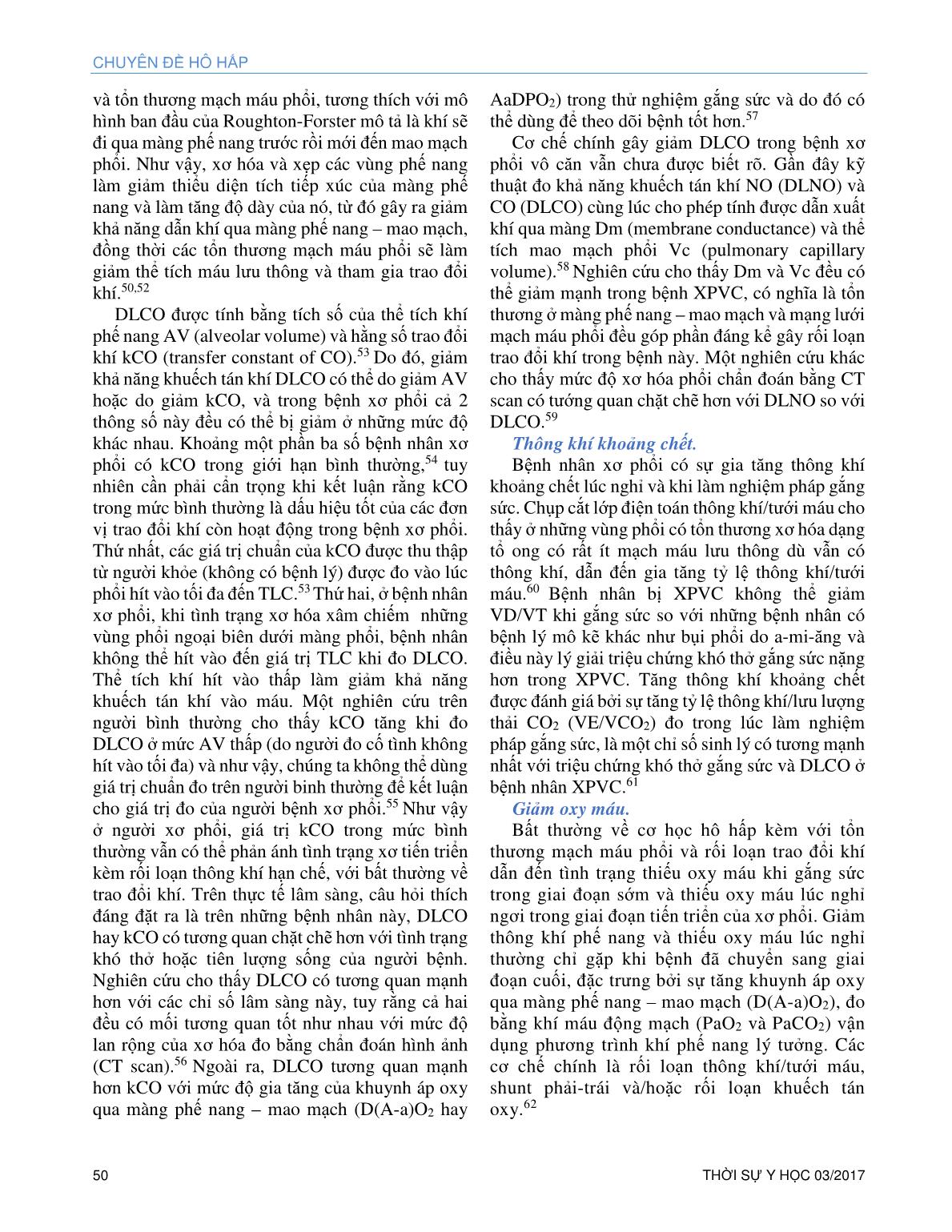
Trang 8
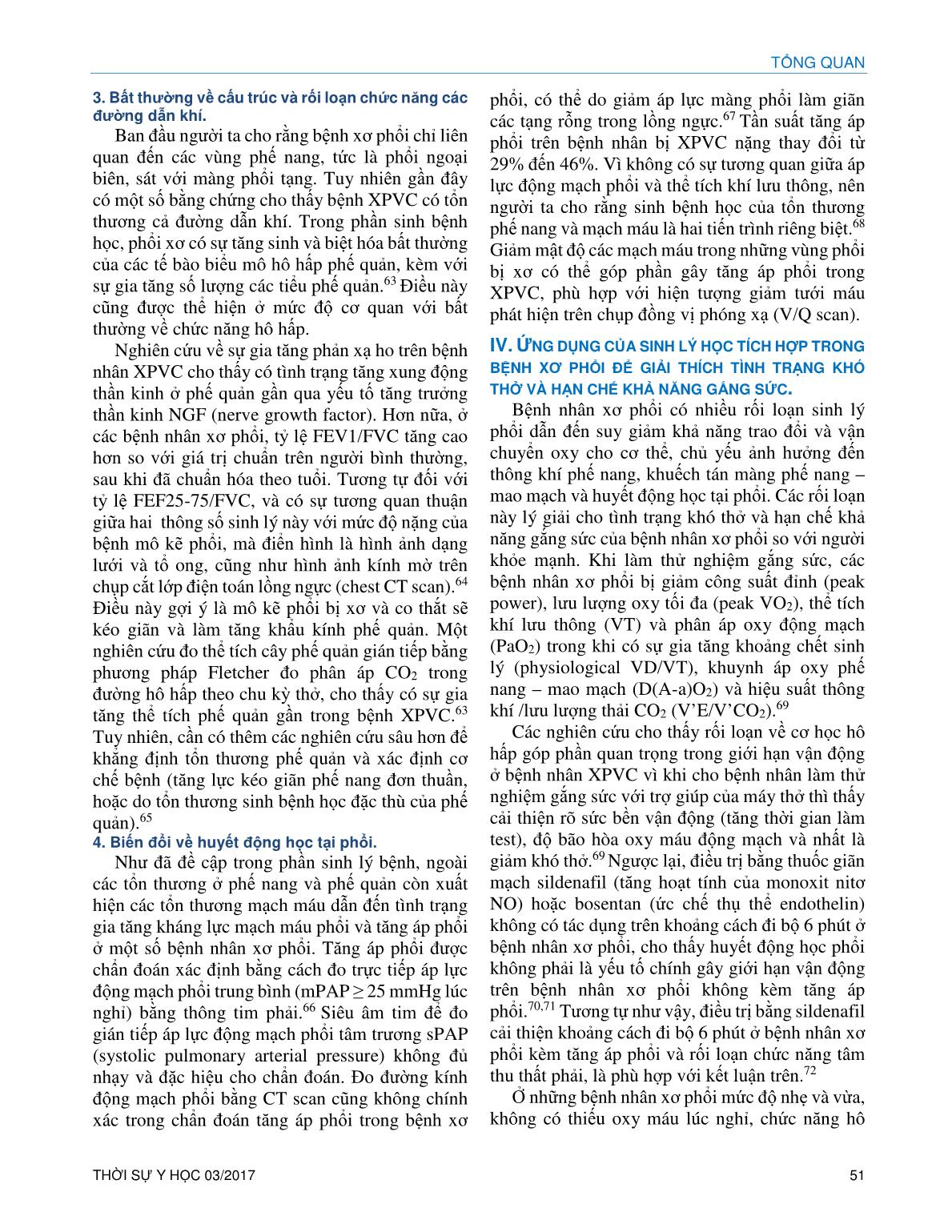
Trang 9
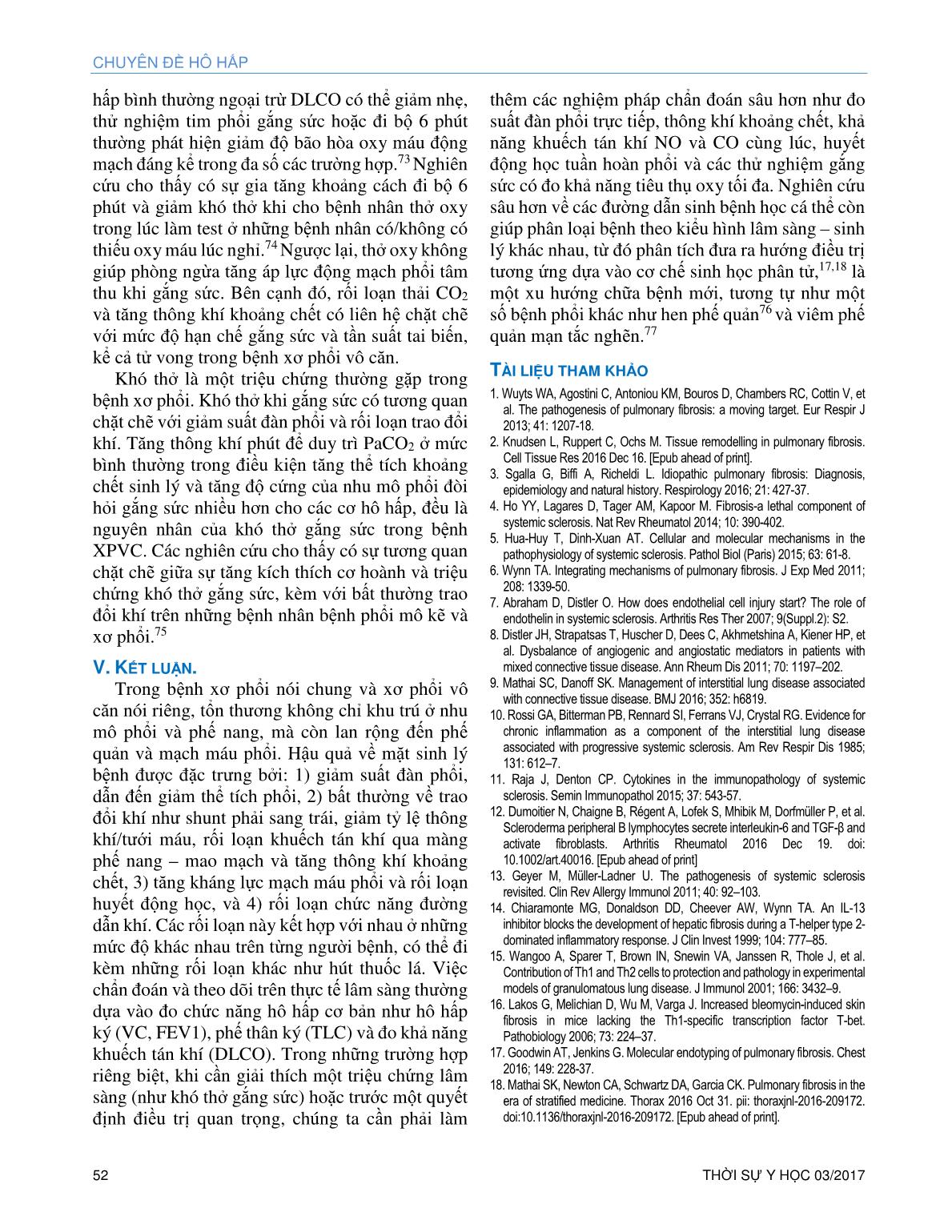
Trang 10
Tải về để xem bản đầy đủ
Bạn đang xem 10 trang mẫu của tài liệu "Bệnh xơ phổi: Từ sinh lý bệnh đến thăm dò chức năng hô hấp", để tải tài liệu gốc về máy hãy click vào nút Download ở trên
Tóm tắt nội dung tài liệu: Bệnh xơ phổi: Từ sinh lý bệnh đến thăm dò chức năng hô hấp
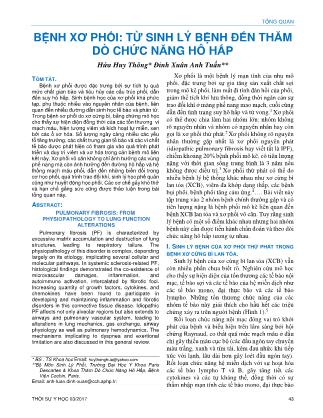
TỔNG QUAN THỜI SỰ Y HỌC 03/2017 43 BỆNH XƠ PHỔI: TỪ SINH LÝ BỆNH ĐẾN THĂM DÒ CHỨC NĂNG HÔ HẤP Hứa Huy Thông* Đinh Xuân Anh Tuấn** TÓM TẮT. Bệnh xơ phổi được đặc trưng bởi sự tích tụ quá mức chất gian bào và tiêu hủy các cấu trúc phổi, dẫn đến suy hô hấp. Sinh bệnh học của xơ phổi khá phức tạp, phụ thuộc nhiều vào nguyên nhân của bệnh, liên quan đến nhiều đường dẫn sinh học tế bào và phân tử. Trong bệnh xơ phổi do xơ cứng bì, bằng chứng mô học cho thấy sự hiện diện đồng thời của các tổn thương vi mạch máu, hiện tượng viêm và kích hoạt tự miễn, xen bởi các ổ xơ hóa. Số lượng ngày càng nhiều các yếu tố tăng trưởng, các chất trung gian tế bào và các vi chất tế bào được phát hiện có tham gia vào quá trình phát triển và duy trì viêm và xơ hóa trong căn bệnh mô liên kết này. Xơ phổi vô căn không chỉ ảnh hưởng các vùng phế nang mà còn ảnh hưởng đến đường hô hấp và hệ thống mạch máu phổi, dẫn đến những biến đổi trong cơ học phổi, quá trình trao đổi khí, sinh lý học phế quản cũng như huyết động học phổi. Các cơ chế gây khó thở và hạn chế gắng sức cũng được thảo luận trong bài tổng quan này. ABSTRACT: PULMONARY FIBROSIS: FROM PHYSIOPATHOLOGY TO LUNG FUNCTION ALTERATIONS Pulmonary fibrosis (PF) is characterized by excessive matrix accumulation and destruction of lung structures, leading to respiratory failure. The physiopathology of this disorder is complex, depending largely on its etiology, implicating several cellular and molecular pathways. In systemic sclerosis-related PF, histological findings demonstrated the co-existence of microvascular damages, inflammation, and autoimmune activation, intercalated by fibrotic foci. Increasing quantity of growth factors, cytokines, and chemokines have been found to participate in developing and maintaining inflammation and fibrotic disorders in this connective tissue disease. Idiopathic PF affects not only alveolar regions but also extends to airways and pulmonary vascular system, leading to alterations in lung mechanics, gas exchange, airway physiology as well as pulmonary hemodynamics. The mechanisms implicating to dyspnea and exertional limitation are also discussed in this general review. * BS , TS Khoa học Email: huythonghua@yahoo.com **Bộ Môn Sinh Lý Phổi, Trường Đại Học Y Khoa Paris Descartes & Khoa Thăm Dò Chức Năng Hô Hấp, Bệnh Viện Cochin, Paris. Email: anh-tuan.dinh-xuan@cch.aphp.fr; Xơ phổi là một bệnh lý mạn tính của nhu mô phổi, đặc trưng bởi sự gia tăng sản xuất chất sợi trong mô kẽ phổi, làm mất đi tính đàn hồi của phổi, giảm thể tích khí lưu thông, đồng thời ngăn cản sự trao đổi khí ở màng phế nang mao mạch, cuối cùng dẫn đến tình trạng suy hô hấp và tử vong.1 Xơ phổi có thể được chia làm hai nhóm lớn: nhóm không rõ nguyên nhân và nhóm có nguyên nhân hay còn gọi là xơ phổi thứ phát.2 Xơ phổi không rõ nguyên nhân thường gặp nhất là xơ phổi nguyên phát (idiopathic pulmonary fibrosis hay viết tắt là IPF), chiếm khoảng 20% bệnh phổi mô kẽ, có tiên lượng nặng với thời gian sống trung bình là 3 năm nếu không được điều trị.3 Xơ phổi thứ phát có thể do nhiều bệnh lý hệ thống khác nhau như xơ cứng bì lan tỏa (XCB), viêm đa khớp dạng thấp, các bệnh bụi phổi, bệnh phổi tăng cảm ứng.4. Bài viết này tập trung vào 2 nhóm bệnh chính thường gặp và có tiên lượng nặng là bệnh phổi mô kẽ liên quan đến bệnh XCB lan tỏa và xơ phổi vô căn. Tuy rằng sinh lý bệnh có một số điểm khác nhau nhưng hai nhóm bệnh này cần được tiến hành chẩn đoán và theo dõi chức năng hô hấp tương tự nhau. I. SINH LÝ BỆNH CỦA XƠ PHỔI THỨ PHÁT TRONG BỆNH XƠ CỨNG BÌ LAN TỎA. Sinh lý bệnh của xơ cứng bì lan tỏa (XCB) vẫn còn nhiều phần chưa biết rõ. Nghiên cứu mô học cho thấy sự hiện diện của tổn thương các tế bào nội mạc, tế bào sợi và các tế bào của hệ miễn dịch như các tế bào mono, đại thực bào và các tế bào lympho. Những tổn thương chức năng của các nhóm tế bào này giải thích cho hầu hết các triệu chứng xảy ra trên người bệnh (Hình 1).5 Rối loạn chức năng nội mạc đóng vai trò khởi phát của bệnh và biểu hiện trên lâm sàng bởi hội chứng Raynaud, co thắt quá mức mạch máu ở đầu chi gây thiếu máu cục bộ (các đầu ngón tay chuyển màu trắng, xanh và tím tái, kèm đau nhức khi tiếp xúc với lạnh, lâu dài hơn gây loét đầu ngón tay). Rối loạn chức năng hệ miễn dịch với sự hoạt hóa các tế bào lympho T và B, gây tăng tiết các cytokines và các tự kháng thể, đồng thời có sự thấm nhập mạn tính các tế bào mono, đại thực bào CHUYÊN ĐỀ HÔ HẤP 44 THỜI SỰ Y HỌC 03/2017 Hình 1. Các cơ chế phân tử và tế bào trong sinh bệnh học xơ hóa của bệnh xơ cứng bì. Kháng thể chống tế bào nội mạc (AECA) gây hoạt hóa tế bào nội mô. Các tế bào này thúc đẩy hiện tượng viêm và tự miễn. Các tế bào viêm tăng tổng hợp và bài tiết nhiều chất trung gian tế bào tiền viêm và gây xơ, thúc đẩy sự biệt hóa các nguyên bào sợi thành tế bào sợi dạng cơ trơn (myofibroblast), dẫn đến xơ hóa lan tỏa và tiến triển. Các chữ viết tắt: VCAM-1: vascular cell adhesion molecule-1; ICAM-1: intercellular adhesion molecule-1; VEGF: vascular endothelial growth factor; NO: nitric oxide; NOS-2: inducible NO synthase; NOS-3: endothelial NO synthase; ET-1: endothelin-1; IL-4- 6, -8, -13: interleukin-4, -6, -8, -13; MIP-1a: macrophage inflammatory protein-1-alpha; MCP-1 (CCL2: chemokine ligand 2): Monocyte chemoattractant protein-1; Rantes (CCL5: chemokine ligand 5): regulated on activation normal T cell expressed and secreted; TGF-b: transforming growth factor-beta; PDGF: platelet-derived growth factor; CTGF: connective tissue growth factor. và lympho T trong các mô cơ quan bị tổn thương. Cuối cùng, quá trình xơ hóa lan tỏa diễn tiến từ từ ở da và các nội tạng như tim, phổi, thận, ống tiêu hóa (thực quản và hội chứng trào ngược dạ dày – thực quản), là hậu quả của quá trình tổn thương nội mạc và viêm vừa kể trên.5,6 I.1. Tổn thương mạ ... ressive systemic sclerosis. Am Rev Respir Dis 1985; 131: 612–7. 11. Raja J, Denton CP. Cytokines in the immunopathology of systemic sclerosis. Semin Immunopathol 2015; 37: 543-57. 12. Dumoitier N, Chaigne B, Régent A, Lofek S, Mhibik M, Dorfmüller P, et al. Scleroderma peripheral B lymphocytes secrete interleukin-6 and TGF-β and activate fibroblasts. Arthritis Rheumatol 2016 Dec 19. doi: 10.1002/art.40016. [Epub ahead of print] 13. Geyer M, Müller-Ladner U. The pathogenesis of systemic sclerosis revisited. Clin Rev Allergy Immunol 2011; 40: 92–103. 14. Chiaramonte MG, Donaldson DD, Cheever AW, Wynn TA. An IL-13 inhibitor blocks the development of hepatic fibrosis during a T-helper type 2- dominated inflammatory response. J Clin Invest 1999; 104: 777–85. 15. Wangoo A, Sparer T, Brown IN, Snewin VA, Janssen R, Thole J, et al. Contribution of Th1 and Th2 cells to protection and pathology in experimental models of granulomatous lung disease. J Immunol 2001; 166: 3432–9. 16. Lakos G, Melichian D, Wu M, Varga J. Increased bleomycin-induced skin fibrosis in mice lacking the Th1-specific transcription factor T-bet. Pathobiology 2006; 73: 224–37. 17. Goodwin AT, Jenkins G. Molecular endotyping of pulmonary fibrosis. Chest 2016; 149: 228-37. 18. Mathai SK, Newton CA, Schwartz DA, Garcia CK. Pulmonary fibrosis in the era of stratified medicine. Thorax 2016 Oct 31. pii: thoraxjnl-2016-209172. doi:10.1136/thoraxjnl-2016-209172. [Epub ahead of print]. TỔNG QUAN THỜI SỰ Y HỌC 03/2017 53 19. Günther J, Rademacher J, van Laar JM, Siegert E, Riemekasten G. Functional autoantibodies in systemic sclerosis. Semin Immunopathol 2015; 37: 529-42. 20. Hasegawa M, Hamaguchi Y, Yanaba K, Bouaziz JD, Uchida J, Fujimoto M, et al. B-lymphocyte depletion reduces skin fibrosis and autoimmunity in the tight-skin mouse model for systemic sclerosis. Am J Pathol 2006; 169: 954– 66. 21. Matsushita T, Hasegawa M, Yanaba K, Kodera M, Takehara K, Sato S. Elevated serum BAFF levels in patients with systemic sclerosis: enhanced BAFF signaling in systemic sclerosis B lymphocytes. Arthritis Rheum 2006; 54: 192–201. 22. Yamakage A, Kikuchi K, Smith EA, LeRoy EC, Trojanowska M. Selective upregulation of platelet-derived growth factor alpha receptors by transforming growth factor beta in scleroderma fibroblasts. J Exp Med 1992; 175: 1227–34. 23. Galindo M, Santiago B, Rivero M, Rullas J, Alcami J, Pablos JL. Chemokine expression by systemic sclerosis fibroblasts: abnormal regulation of monocyte chemoattractant protein 1 expression. Arthritis Rheum 2001; 44: 1382–6. 24. Jelaska A, Korn JH. Role of apoptosis and transforming growth factor beta1 in fibroblast selection and activation in systemic sclerosis. Arthritis Rheum 2000; 43: 2230–9. 25. LeRoy EC. Increased collagen synthesis by scleroderma skin fibroblasts in vitro: a possible defect in the regulation or activation of the scleroderma fibroblast. J Clin Invest 1974; 54: 880–9. 26. Gilbane AJ, Denton CP, Holmes AM. Scleroderma pathogenesis: a pivotal role for fibroblasts as effector cells. Arthritis Res Ther 2013; 15: 215. 27. Varga J. Scleroderma and Smads: dysfunctional Smad family dynamics culminating in fibrosis. Arthritis Rheum 2002; 46: 1703–13. 28. Kawakami T, Ihn H, Xu W, Smith E, LeRoy C, Trojanowska M. Increased expression of TGF-beta receptors by scleroderma fibroblasts: evidence for contribution of autocrine TGF-beta signaling to scleroderma phenotype. J Invest Dermatol 1998; 110: 47–51. 29. Trojanowska M. Role of PDGF in fibrotic diseases and systemic sclerosis. Rheumatology (Oxford) 2008; 47(Suppl 5): v2–4. 30. Gharaee-Kermani M, Denholm EM, Phan SH. Costimulation of fibroblast collagen and transforming growth factor beta1 gene expression by monocyte chemoattractant protein-1 via specific receptors. J Biol Chem 1996; 271: 17779–84. 31. Yamamoto T, Eckes B, Mauch C, Hartmann K, Krieg T. Monocyte chemoattractant protein-1 enhances gene expression and synthesis of matrix metalloproteinase-1 in human fibroblasts by an autocrine IL-1 alpha loop. J Immunol 2000; 164: 6174–9. 32. Dees C, Zerr P, Tomcik M, Beyer C, Horn A, Akhmetshina A, et al. Inhibition of Notch signaling prevents experimental fibrosis and induces regression of established fibrosis. Arthritis Rheum 2011; 63: 1396–404. 33. Distler A, Ziemer C, Beyer C, Lin NY, Chen CW, Palumbo-Zerr K, et al. Inactivation of evenness interrupted (EVI) reduces experimental fibrosis by combined inhibition of canonical and non-canonical Wnt signalling. Ann Rheum Dis 2014; 73: 624–7. 34. Kinnula VL, Mylla¨rniemi M. Oxidant-antioxidant imbalance as a potential contributor to the progression of human pulmonary fibrosis. Antioxid Redox Signal 2008; 10: 727–38. 35. Sambo P, Baroni SS, Luchetti M, Paroncini P, Dusi S, Orlandini G, et al. Oxidative stress in scleroderma: maintenance of scleroderma fibroblast phenotype by the constitutive up-regulation of reactive oxygen species generation through the NADPH oxidase complex pathway. Arthritis Rheum 2001; 44: 2653–64. 36. Svegliati S, Cancello R, Sambo P, Luchetti M, Paroncini P, Orlandini G, et al. Platelet-derived growth factor and reactive oxygen species (ROS) regulate Ras protein levels in primary human fibroblasts via ERK1/2. Amplification of ROS and Ras in systemic sclerosis fibroblasts. J Biol Chem 2005; 280: 36474–82. 37. Servettaz A, Goulvestre C, Kavian N, Nicco C, Guilpain P, Che´reau C, et al. Selective oxidation of DNA topoisomerase 1 induces systemic sclerosis in the mouse. J Immunol 2009; 182: 5855–64. 38. Bei Y, Hua-Huy T, Nicco C, Duong-Quy S, Le-Dong NN, Tiev KP, Chéreau C, Batteux F, Dinh-Xuan AT. RhoA/Rho-kinase activation promotes lung fibrosis in an animal model of systemic sclerosis. Exp Lung Res 2016; 42: 44-55. 39. Batteux F, Kavian N, Servettaz A. New insights on chemically induced animal models of systemic sclerosis. Curr Opin Rheumatol 2011; 23: 511-8. 40. Plantier L, Crestani B, Wert SE, Dehoux M, Zweytick B, Guenther A, et al. Ectopic respiratory epithelial cell differentiation in bronchiolised distal airspaces in idiopathic pulmonary fibrosis. Thorax 2011; 66: 651–7. 41. Vuorinen K, Ohlmeier S, Lepparanta O, Salmenkivi K, Myllarniemi M, Kinnula VL. Peroxiredoxin II expression and its association with oxidative stress and cell proliferation in human idiopathic pulmonary fibrosis. J Histochem Cytochem Off J Histochem Soc 2008; 56: 951–9. 42. Hanumegowda C, Farkas L, Kolb M. Angiogenesis in pulmonary fibrosis: too much or not enough? Chest 2012; 142: 200–7. 43. Yernault JC, de Jonghe M, de Coster A, Englert M. Pulmonary mechanics in diffuse fibrosing alveolitis. Bull Physiopathol Respir (Nancy) 1975; 11: 231- 44. 44. Thannickal VJ, Henke CA, Horowitz JC, Noble PW, Roman J, Sime PJ, et al. Matrix biology of idiopathic pulmonary fibrosis: a workshop report of the national heart, lung, and blood institute. Am J Pathol 2014; 184: 1643–51. 45. Campo I, Zorzetto M, Mariani F, Kadija Z, Morbini P, Dore R, et al. A large kindred of pulmonary fibrosis associated with a novel ABCA3 gene variant. Respir Res 2014; 15: 43. 46. Galetke W, Feier C, Muth T, Ruehle K-H, Borsch-Galetke E, Randerath W. Reference values for dynamic and static pulmonary compliance in men. Respir Med 2007; 101: 1783–9. 47. Zielonka TM, Demkow U, Radzikowska E, Bialas B, Filewska M, Zycinska K, et al. Angiogenic activity of sera from interstitial lung disease patients in relation to pulmonary function. Eur J Med Res 2010; 15(Suppl.2): 229–34. 48. Orens JB, Kazerooni EA, Martinez FJ, Curtis JL, Gross BH, Flint A, et al. The sensitivity of high resolution CT in detecting idiopathic pulmonary fibrosis proved by open lung biopsy. A prospective study. Chest 1995; 108: 109–15. 49. Fulmer JD, Roberts WC, von Gal ER, Crystal RG. Morphologic-physiologic correlates of the severity of fibrosis and degree of cellularity in idiopathic pulmonary fibrosis. J Clin Invest 1979; 63: 665–76. 50. Martinez FJ, Flaherty K. Pulmonary function testing in idiopathic interstitial pneumonias. Proc Am Thorac Soc 2006; 3: 315–21. 51. Mura M, Zompatori M, Pacilli AMG, Fasano L, Schiavina M, Fabbri M. The presence of emphysema further impairs physiologic function in patients with idiopathic pulmonary fibrosis. Respir Care 2006; 51: 257–65. 52. Cortes-Telles A, Forkert L, O’Donnell DE, Moran-Mendoza O. Idiopathic pulmonary fibrosis: new insights on functional characteristics at diagnosis. Can Respir J 2014; 21: e55-60. 53. Macintyre N, Crapo RO, Viegi G, Johnson DC, van der Grinten CPM, Brusasco V, et al. Standardisation of the single-breath determination of carbon monoxide uptake in the lung. Eur Respir J 2005; 26: 720–35. 54. Wallaert B, Wemeau-Stervinou L, Salleron J, Tillie-Leblond I, Perez T. Do we need exercise tests to detect gas exchange impairment in fibrotic idiopathic interstitial pneumonias? Pulm Med 2012; 2012: 657180. 55. Frans A, Nemery B, Veriter C, Lacquet L, Francis C. Effect of alveolar volume on the interpretation of single breath DLCO. Respir Med 1997; 91: 263–73. 56. Wells AU, King AD, Rubens MB, Cramer D, du Bois RM, Hansell DM. Lone cryptogenic fibrosing alveolitis: a functional-morphologic correlation based on extent of disease on thin-section computed tomography. Am J Respir Crit Care Med 1997; 155: 1367–75. 57. Agusti C, Xaubet A, Agusti AG, Roca J, Ramirez J, Rodriguez-Roisin R. Clinical and functional assessment of patients with idiopathic pulmonary fibrosis: results of a 3 year follow-up. Eur Respir J 1994; 7: 643–50. 58. Zavorsky GS, Hsia CC, Hughes JM, Borland CD, Guénard H, van der Lee I, et al. Standardisation and application of the single-breath determination of CHUYÊN ĐỀ HÔ HẤP 54 THỜI SỰ Y HỌC 03/2017 nitric oxide uptake in the lung. Eur Respir J 2017 Feb 8; 49(2). pii: 1600962. doi: 10.1183/13993003.00962-2016. 59. Barisione G, Brusasco C, Garlaschi A, Baroffio M, Brusasco V. Lung diffusing capacity for nitric oxide as a marker of fibrotic changes in idiopathic interstitial pneumonias. J Appl Physiol (1985) 2016; 120: 1029-38. 60. Strickland NH, Hughes JM, Hart DA, Myers MJ, Lavender JP. Cause of regional ventilation-perfusion mismatching in patients with idiopathic pulmonary fibrosis: a combined CT and scintigraphic study. AJR Am J Roentgenol 1993; 161: 719–25. 61. Manali ED, Lyberopoulos P, Triantafillidou C, Kolilekas LF, Sotiropoulou C, Milic-Emili J, et al. MRC chronic Dyspnea Scale: Relationships with cardiopulmonary exercise testing and 6-minute walk test in idiopathic pulmonary fibrosis patients: a prospective study. BMC Pulm Med 2010; 10: 32. 62. Agusti AG, Roca J, Gea J, Wagner PD, Xaubet A, Rodriguez-Roisin R. Mechanisms of gas exchange impairment in idiopathic pulmonary fibrosis. Am Rev Respir Dis 1991; 143: 219–25. 63. Plantier L, Debray M-P, Estellat C, Flamant M, Roy C, Bancal C, et al. Increased volume of conducting airways in idiopathic pulmonary fibrosis is independent of disease severity: a volumetric capnography study. J Breath Res 2016; 10: 16005. 64. Hope-Gill BDM, Hilldrup S, Davies C, Newton RP, Harrison NK. A study of the cough reflex in idiopathic pulmonary fibrosis. Am J Respir Crit Care Med 2003; 168: 995–1002. 65. Baier H, Zarzecki S, Wanner A. Influence of lung inflation on the cross- sectional area of central airways in normals and in patients with lung disease. Respirology 1981; 41: 145–54. 66. Caminati A, Cassandro R, Harari S. Pulmonary hypertension in chronic interstitial lung diseases. Eur Respir Rev 2013; 22: 292–301. 67. Devaraj A, Wells AU, Meister MG, Corte TJ, Hansell DM. The effect of diffuse pulmonary fibrosis on the reliability of CT signs of pulmonary hypertension. Radiology 2008; 249: 1042–9. 68. Nathan SD, Shlobin OA, Ahmad S, Urbanek S, Barnett SD. Pulmonary hypertension and pulmonary function testing in idiopathic pulmonary fibrosis. Chest 2007;131: 657–63. 69. Moderno EV, Yamaguti WPS, Schettino GPP, Kairalla RA, Martins MA, Carvalho CRR, et al. Effects of proportional assisted ventilation on exercise performance in idiopathic pulmonary fibrosis patients. Respir Med 2010; 104: 134–41. 70. Idiopathic Pulmonary Fibrosis Clinical Research Network, Zisman DA, Schwarz M, Anstrom KJ, Collard HR, Flaherty KR, et al. A controlled trial of sildenafil in advanced idiopathic pulmonary fibrosis. N Engl J Med 2010; 363: 620–8. 71. King TE, Behr J, Brown KK, du Bois RM, Lancaster L, de Andrade JA, et al. BUILD-1: a randomized placebo-controlled trial of bosentan in idiopathic pulmonary fibrosis. Am J Respir Crit Care Med 2008; 177: 75–81. 72. Han MK, Bach DS, Hagan PG, Yow E, Flaherty KR, Toews GB, et al. Sildenafil preserves exercise capacity in patients with idiopathic pulmonary fibrosis and right-sided ventricular dysfunction. Chest 2013; 143: 1699–708. 73. Hughes JM, Lockwood DN, Jones HA, Clark RJ. DLCO/Q and diffusion limitation at rest and on exercise in patients with interstitial fibrosis. Respir Physiol 1991; 83: 155–66. 74. Visca D, Montgomery A, de Lauretis A, Sestini P, Soteriou H, Maher TM, et al. Ambulatory oxygen in interstitial lung disease. Eur Respir J 2011; 38: 987- 90. 75. Triantafillidou C, Manali E, Lyberopoulos P, Kolilekas L, Kagouridis K, Gyftopoulos S, et al. The Role of Cardiopulmonary Exercise Test in IPF Prognosis. Pulm Med 2013; 2013: 514817. 76. Sears MR. Predicting asthma outcomes. J Allergy Clin Immunol 2015; 136: 829–36. 77. Woodruff PG, Agusti A, Roche N, Singh D, Martinez FJ. Current concepts in targeting chronic obstructive pulmonary disease pharmacotherapy: making progress towards personalised management. Lancet 2015; 385(9979): 1789-98.
File đính kèm:
 benh_xo_phoi_tu_sinh_ly_benh_den_tham_do_chuc_nang_ho_hap.pdf
benh_xo_phoi_tu_sinh_ly_benh_den_tham_do_chuc_nang_ho_hap.pdf

